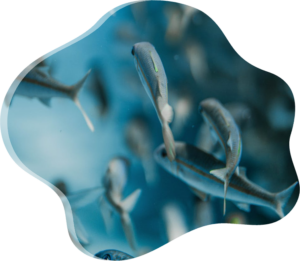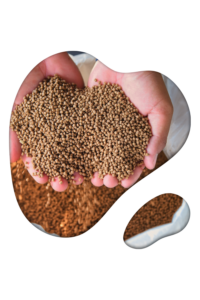What Is Fishmeal? A Complete Guide
If you’ve ever wondered “What is fishmeal?”, you’re not alone. This high-protein ingredient is a staple in animal, fish and pet nutrition, known for its nutritional density and sustainability potential. But what exactly is fishmeal, how is it made, and why is it used in pet food and animal feed?
Let’s dive into the world of fishmeal and explore why it’s making waves in sustainable food production.
What Is Fishmeal?
Fishmeal is a highly nutritious feed ingredient made by cooking, pressing, drying, and grinding either whole fish (typically small, oily fish like anchovies or menhaden) or fish byproducts from seafood processing. The result is a powder rich in protein, omega-3 fatty acids, vitamins, and minerals.
Key Facts About Fishmeal:
- Protein content: Typically 60%–72%
- Contains essential amino acids for optimal growth
- Packed with EPA and DHA omega-3s
- Easily digestible for pets, livestock and farmed fish
 What Is Fishmeal Used For?
What Is Fishmeal Used For?
Fishmeal is widely used in:
- Aquaculture feed (e.g. for salmon, trout, tilapia)
- Pet food (especially premium or functional formulas)
- Livestock feed (poultry, piglets, cattle)
- Organic fertiliser (due to its nitrogen and phosphorus content)
Its high digestibility and nutrient density make it especially valuable for young or high-performing animals.
Why Is Fishmeal Used in Pet Food?
Fishmeal is increasingly being used in pet food for both dogs and cats due to its superior amino acid profile, which supports healthy muscle development. It’s also a rich source of omega-3 fatty acids that help promote healthy skin and a shiny coat.
Thanks to its strong palatability, fishmeal is especially appealing to picky eaters. In addition, it offers valuable support for joint health, cognitive function, and immune system strength.
Many premium pet food brands also choose fishmeal for use in grain-free or hypoallergenic formulations, making it a versatile ingredient for a wide range of dietary needs.
How Is Fishmeal Made?
Fishmeal production involves several key steps:
- Raw material selection – either whole fish or leftover parts like heads, tails, and bones
- Cooking – fish are steamed to break down tissues
- Pressing – separates liquid from solids
- Drying – moisture is removed to preserve nutrients
- Grinding – the final product is ground into a fine powder
When processed properly, high-quality fishmeal retains its nutritional value and can be stored for extended periods.
Is Fishmeal Sustainable?
Yes—when sourced responsibly, fishmeal can be a sustainable ingredient.
Here’s how:
- It often comes from byproducts of the seafood industry, reducing waste
- Certified sources (e.g. MSC-certified fishmeal) follow sustainable fishing practices
- Lower carbon footprint than land-based protein sources like beef or poultry
- Supports a circular economy by using materials that might otherwise go to waste
Look for certifications like Marine Stewardship Council (MSC) or IFFO RS to ensure sustainable sourcing.
What Are the Drawbacks or Challenges of Fishmeal?
While fishmeal offers many nutritional benefits, there are a few important considerations for pet food manufacturers. One of the main concerns is sourcing. If not harvested sustainably, fishmeal production can contribute to overfishing and disrupt marine ecosystems. It’s essential to ensure the fishmeal is sourced responsibly from well-managed fisheries.
Another factor to consider is price volatility. The cost of fishmeal can fluctuate significantly depending on seasonal fishery yields and global demand, which can affect production costs and pricing.
Storage can also be a challenge. Fishmeal is highly sensitive to moisture and can spoil if not stored in proper conditions, leading to quality degradation and potential health risks for pets. Additionally, without the use of proper antioxidants, fishmeal is prone to oxidation, which can result in rancidity and nutrient loss.
Lastly, although rare, some pets may have sensitivities or allergies to fish proteins. It’s important to monitor for any adverse reactions, especially in hypoallergenic or limited-ingredient diets.
To mitigate these challenges, pet food manufacturers should opt for high-quality, traceable fishmeal sourced from certified sustainable suppliers. This ensures both nutritional integrity and environmental responsibility.
Fishmeal FAQs
Q: What is fishmeal made of?
Fishmeal is made from cooked, dried, and ground whole fish or fish processing byproducts.
Q: Is fishmeal good for dogs and cats?
Yes, it’s a digestible source of protein and omega-3s that supports healthy skin, coat, and joints.
Q: Is fishmeal sustainable?
It can be—especially when it’s sourced from certified, responsibly managed fisheries.
Q: What does fishmeal look like?
Fishmeal is a dry, brown powder that smells like fish and is used as an ingredient in animal feeds.
Q: Can fishmeal replace meat in pet food?
Fishmeal can partially or fully replace meat proteins, depending on the formula and nutritional goals.
Conclusion: Why Fishmeal Still Matters
Fishmeal is a nutritional powerhouse that plays a crucial role in pet food, livestock nutrition, and aquaculture. When responsibly sourced and properly processed, it offers a sustainable, digestible, and high-protein alternative to traditional animal proteins.
Whether you’re a pet food manufacturer or a curious pet parent, understanding what fishmeal is—and how it benefits both animals and the planet—can help you make more informed decisions.

